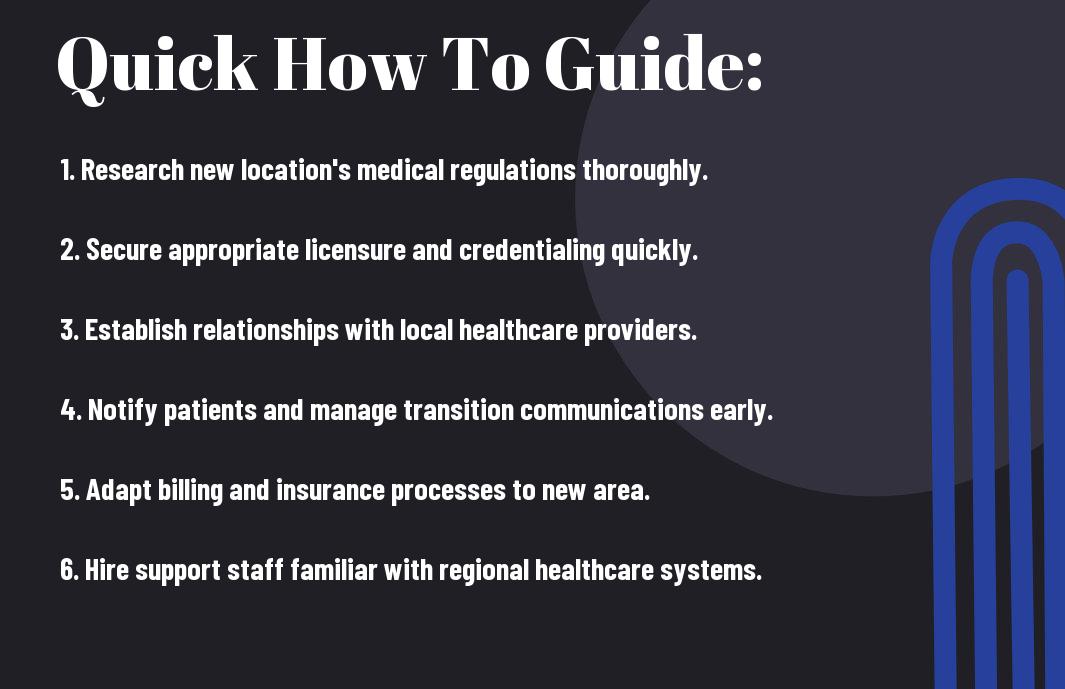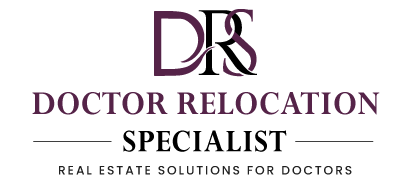Relocation of your medical practice can present numerous hurdles that may seem daunting. From navigating administrative regulations to managing patient transitions, the challenges can be overwhelming. However, by understanding these common obstacles and implementing practical strategies, you can ensure a smoother transition. In this guide, you will discover the top five challenges physicians face when relocating their practices and actionable solutions to help you overcome them effectively.

Navigating Regulatory Maze: Licensing and Accreditation
Transitioning your practice to a new location means confronting complex regulatory requirements. Each state has its own set of licensing and accreditation standards that you must adhere to for a smooth relocation. Understanding these requirements is important to maintaining your practice and securing your patients’ trust. Delays or oversights in documentation can lead to interruptions in service and compliance issues that can affect your practice’s reputation.
Understanding State-specific Requirements
Diving into the specifics of state regulations is vital. Each state mandates different levels of licensure, continuing education credits, and scope of practice laws. Thoroughly researching the local medical boards in your new state provides insights into what is required to operate legally. Engaging with professional networks or legal experts familiar with the area will help you avoid pitfalls and ensure that your practice meets all necessary regulatory guidelines.
Ensuring Compliance with Insurance and Medications
Insurance compliance and medication regulations vary significantly from state to state. Properly navigating these requirements involves reviewing the differing policies for malpractice insurance and how they apply in your new locale. Furthermore, regulations concerning medication prescriptions—including controlled substances—must be thoroughly understood. A systematic review and collaboration with local pharmacists can streamline this process and minimize the risk of non-compliance.
In a recent case, a physician relocating from California to Texas faced severe ramifications due to non-compliance with prescription regulations. They inadvertently continued to prescribe controlled substances without adjusting their state licensing, leading to a suspension of their medical license. This resulted in significant delays in patient care and financial loss. Ensuring compliance with insurance policies and strict medication regulations can be addressed through comprehensive staff training and the establishment of firm processes for verifying state-specific requirements. By staying informed and proactive, you can protect your practice and your patients effectively.

Financial Hurdles: Budgeting for Relocation Expenses
Budgeting for relocation expenses requires thorough planning and realistic financial forecasting. As you prepare for this transition, consider not only the immediate costs associated with moving but also the ongoing expenses that may arise in your new location. This includes renovations, equipment transportation, new staff training, and potential disruptions in patient care that could affect your revenue stream. Setting aside a contingency fund for unexpected expenses can alleviate some financial pressure during this critical time.
Estimating Costs: Hidden Fees and Surprises
Hidden fees often catch you off guard when relocating your practice. Consider factors like utility deposits, moving service charges, disposal fees for outdated equipment, and even registration fees for your new location. Be sure to account for the cost of redesigning your new office space to meet compliance and regulatory standards as well. Gathering multiple estimates and tapping into local resources can help clarify these financial expectations and ensure you’re not blindsided during the move.
Securing Funding: Loans, Grants, and Other Resources
Accessing financial resources can make a significant impact during your relocation. Explore options for small business loans, which can provide necessary capital. Additionally, local healthcare organizations or government agencies may offer grants aimed at improving healthcare access that you could apply for. Understanding the various funding opportunities available can ease the financial burden and help you maintain your practice’s stability throughout the transition.
In particular, small business administration (SBA) loans can be especially favorable due to lower interest rates and longer repayment terms. Research local or state grants that support medical practices in underserved areas. Collaborate with your current bank or credit union as they may have specialized programs for healthcare practitioners. Document your practice’s financial health and future projections to bolster your funding applications, as lenders and grant committees will want to see a clear plan for how the funds will be utilized effectively in your practice’s new location.
Patient Retention Strategies: Merging Old and New
Successfully relocating your practice means finding innovative ways to retain your existing patients while also welcoming new ones. Retention strategies can include personalized outreach, maintaining familiarity through communication, and creating a welcoming environment that reflects your practice’s values. Bridging the gap between your old and new locations ensures continuity in care, cultivates patient loyalty, and fosters growth.
Communicating Change Effectively to Patient Base
Open and transparent communication forms the backbone of a successful transition. Sending clear, informative announcements about your move via email, newsletters, and social media channels reassures patients about their care continuity. A well-crafted message should include details such as the new location, the date of the move, and how the transition will benefit them. Regular updates leading up to your relocation can help minimize anxiety and keep patients engaged during the process.
Building New Relationships in the Community
Your new location presents an opportunity to forge new relationships within the community. Engaging with local businesses, attending community events, and collaborating with other healthcare providers can help establish your presence. Consider organizing health fairs, free workshops, or informational sessions at your new site to connect with potential patients. These outreach efforts not only enhance visibility but also create vital networks that can lead to referrals and partnerships.
Building relationships in the community requires an active approach. Participating in local events, sponsoring youth sports teams, or offering free health screenings can significantly enhance your visibility. Attend Chamber of Commerce meetings or join local healthcare organizations to meet fellow professionals. By embedding yourself in community life, you create a sense of trust and familiarity that encourages new patients to choose your practice for their healthcare needs. Personal connections often lead to referrals, bolstering your patient base in the long run.
Technology Transition: Migrating Systems and Data
A smooth technology transition is important for practice relocation, with a focus on migrating systems and data without interruption to patient care or services. Ensuring that all technology elements function effectively at the new location requires meticulous planning, which includes evaluating current software, hardware, and network infrastructure. You will need to assess compatibility and any necessary upgrades to streamline your operations and maintain patient data integrity throughout the transition.
Choosing Compatible EHR Systems and Tools
Selecting an Electronic Health Record (EHR) system that easily integrates with your existing tools can make a significant difference in the relocation process. Conduct a thorough analysis of your current EHR’s functionality and compare it against potential systems at the new location. You want software that supports your practice’s unique needs and maintains continuity in patient care as you transition. Prioritize interoperability so you can seamlessly access and transfer data without losing any critical patient information.
Managing Data Security During the Move
Data security is a top concern when relocating your practice, particularly as you move sensitive patient information. Protecting this data from breaches or loss during transit requires a comprehensive plan encompassing multiple layers of security. Encrypt all data files before moving them, use secure cloud storage solutions, and make certain to work with IT professionals skilled in healthcare compliance to ensure patient information remains protected throughout the process. Conduct risk assessments and staff training to reinforce the significance of data privacy, creating an environment where confidentiality is prioritized.
During the move, consider implementing multi-factor authentication and strict access controls to safeguard your systems. It’s advisable to keep physical copies of critical data as a backup and utilize secure, encrypted methods for digital transfers. Regular audits of your data processes can help identify vulnerabilities, ensuring you tighten any loopholes before, during, and after the transition. Building a relationship with a reliable IT partner or consultant who has experience with healthcare relocations can be invaluable in addressing any unexpected issues that arise, further solidifying your data security strategy.
Staff Dynamics: Retaining Talent Through Transition
As you relocate your practice, maintaining staff morale and cohesion is vital. Navigating a move can create uncertainty among your team, which may affect productivity and retention. Open communication, reassurance of stability, and transparency about changes will help foster a supportive environment. Involving your staff in the transition process also nurtures a sense of ownership, minimizing resistance and enhancing team unity during this challenging period.
Addressing Employee Concerns and Responsibilities
Your employees may express concerns about job security, changes in their work environment, and potential alterations in their roles. Actively addressing these concerns involves regular consultations and updates, reassuring them of their value to the practice. Clearly defined responsibilities during the transition can alleviate anxiety, encouraging a collaborative atmosphere where everyone contributes to a seamless relocation.
Creating Incentives to Maintain Morale and Productivity
Offering incentives is a proactive way to maintain staff motivation throughout the transition. You can implement performance bonuses, additional time off, or flexible working arrangements as a gesture of appreciation. Small rewards, such as gift cards or team outings can reinforce a sense of camaraderie and communal effort during this period of change.
Beyond tangible incentives, fostering an inclusive culture plays a significant role in keeping morale high. Provide opportunities for team-building exercises and supportive workshops to help them adapt to their new roles and environment. Regular check-ins to gauge employee feelings and feedback about the relocation can also create an open forum for dialogue, revealing insights that help tailor your efforts to better fit your team’s unique dynamics. Acknowledging and addressing their needs actively shows your investment in their well-being, ultimately leading to a more committed and productive workforce throughout the transition.
Conclusion
Conclusively, understanding the top challenges you may face when relocating your practice can empower you to navigate this complex process more effectively. From managing patient retention to addressing legal compliance and logistics, being well-prepared allows you to implement strategies that minimize disruption. By assessing your new market, leveraging technology, and engaging with your community early on, you can ensure a more seamless transition. Ultimately, your proactive approach will pave the way for a successful relocation and continued growth in your medical practice.

